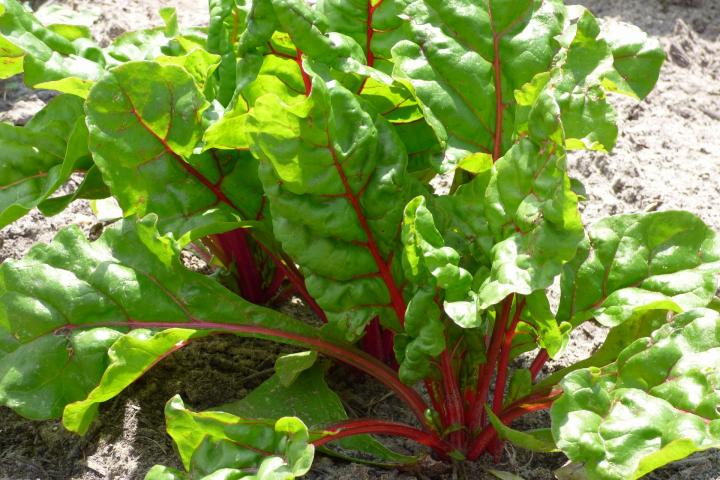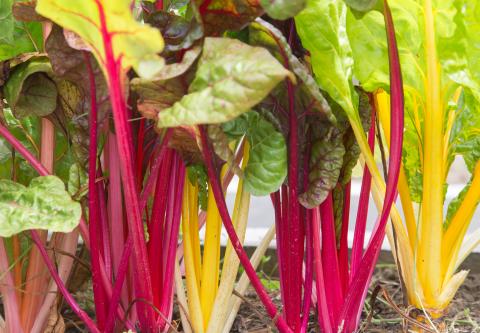Learn how to grow Swiss chard—or simply “chard”—a member of the beet family. It does well in both cool and warm weather. It is a nutritional superfood, high in vitamins A, C, and K, as well as minerals, phytonutrients, and fiber. Plus, its rainbow of colors is beautiful! See our Chard growing guide for information from planting to harvesting.
About Growing Swiss Chard
Similar to beets, both the stems and leaves of chard can be eaten cooked or raw. Swiss chard is prolific—leave plenty of room in the garden bed! It has a mild flavor, adding nutrition and color to salads, pastas, pizzas, quiches, sandwiches, and more.
Typically grown as a cool-season crop because it grows quickly and easily during the cooler temperatures of spring and fall, chard is tolerant of hotter temperatures, too. Its growth will slow down in summer, but chard’s higher heat tolerance makes it a great salad green to grow when it gets too hot out for the others.
Chard is a superfood, high in vitamins A, C, and K. It doesn’t have that bitter taste that a lot of other greens have, and it makes a good substitute for spinach or kale, if you’re not a fan of those superfoods.
On top of all its virtues as a garden vegetable, chard is a lovely edible ornamental plant, coming in many different colors to mix with landscaping or in containers. Why, you could even use chard in a vase or bouquet, mixed with flowers or on its own. Why should flowers have all the fun?
Choosing a Location
- Chard will tolerate partial sun, but grows best in full sun, and also prefers a soil pH between 6.0 and 7.0 (slightly acidic to neutral).
- Before planting, mix aged manure and/or compost into the soil.
When to Plant
- For the spring season, plant chard seeds 2 to 3 weeks before the last spring frost date.
- For a fall harvest, plant chard seeds about 40 days before the first fall frost date. (Many varieties will tolerate a light frost.)
- To speed germination, soak seeds in water for 24 hours prior to planting.
Planting Seeds
- When ready to plant, apply 5-10-10 fertilizer to the area.
- Sow seeds 1/2 to 1 inch deep, 2 to 6 inches apart, in rows 18 inches apart.
- Continue planting seeds at 10-day intervals for a month.

- When plants are 3 to 4 inches tall, thin to 4 to 6 inches apart or 6 to 12 inches if plants are large.
- Use scissors to avoid disturbing nearby plant roots. You can eat the cuttings.
- Chard usually does just fine without the use of fertilizer, but if yours seems to be staying small, consider applying a balanced fertilizer halfway through the season.
- Water evenly and consistently to help it grow better. Water plants often during dry spells in the summer.
- Mulch the plants to help conserve moisture and suppress weeds.
- When plants are about 1 foot tall, cut leaves back to 3 to 5 inches to encourage new tender growth. If chard plants become overgrown, they become less flavorful. Eat what you cut back.
Check out this video to learn how to grow Swiss chard:
- Aphids
- Leaf miners
- Cercospora leaf spot
- Slugs
- ‘Bright Lights’: Dark green leaves on multicolor stems; bolt resistant but less frost-hardy.
- ‘Fordhook Giant’: Dark green leaves, white stems; compact plants.
- ‘Lucullus’: Green leaves, white stems; heat-tolerant.
- ‘Peppermint’: Green leaves, pink-and-white striped stems; bolt-resistant; good for containers.
- ‘Rainbow’: Red, pink, white, yellow, orange, and striped leaves and stems.
- ‘Rhubarb’: Dark green leaves, deep-red stems; sow after risk of frost has passed or it may bolt.
- ‘Ruby Red’: Green leaves, bright-red stems; sow after risk of frost has passed or it may bolt.
- Begin to harvest when the plants are 6 to 8 inches tall, depending on which size leaves you desire.
- Cut off outer leaves 1-1/2 inches above the ground with a sharp knife. Avoid damaging the plant’s center. Eat what you cut.
- Harvest regularly, and the plants will produce continually. Use the “cut-and-come-again” harvesting technique, taking the largest, oldest leaves and leaving the young ones to continue growing.
- To extend the harvest, lift the plant, with roots in the soil, and transfer to a container in a greenhouse. Maintain the temperature at around 50°F. Initially, the chard will appear limp, but it should rebound.
How to Store Swiss Chard
- Rinse off Swiss chard leaves and store them in the refrigerator in ventilated plastic bags.
- To use, draw a sharp knife along the ribs to separate the leaves.
- The leaves are eaten as greens. You can cook them like spinach or eat them raw.
- You can cook the ribs like asparagus (steamed, roasted, sautéed).
- Swiss chard originated in—you guessed it—Mediterranean Europe! Oddly enough, chard is not native to Switzerland at all. According to legend, a Swiss botanist was responsible for determining chard’s scientific name and the “Swiss” just stuck!
- Embrace your leafy greens! Learn more about the health benefits of going green!
- Chard can be used in salads to add color, in smoothies, in soups and stews, on pizzas, in sandwiches in place of lettuce, in quiches, and anywhere you use spinach or kale (especially if you dislike the latter).
- Swiss chard holds it shape well when cooked and adds a nutritious boost.




